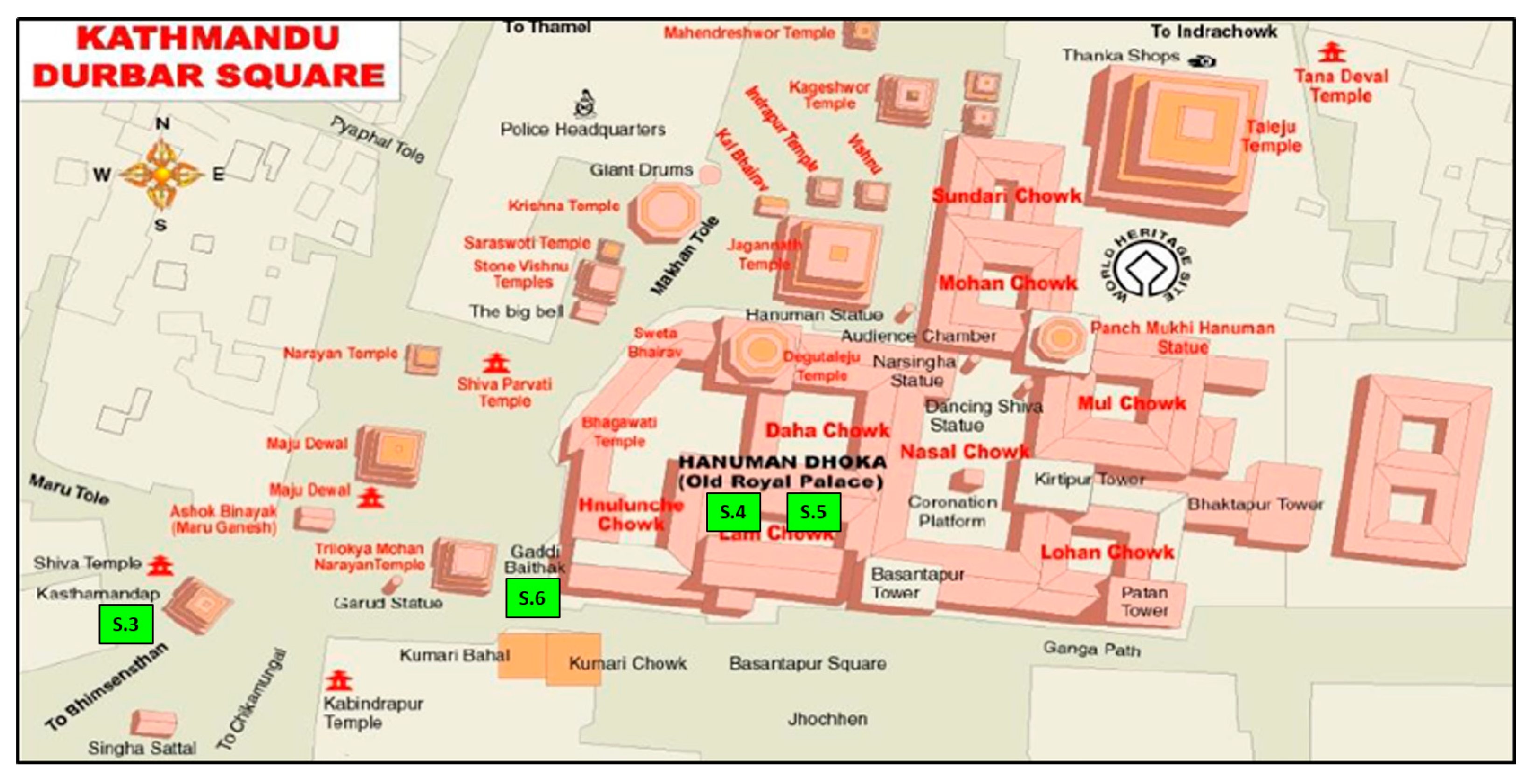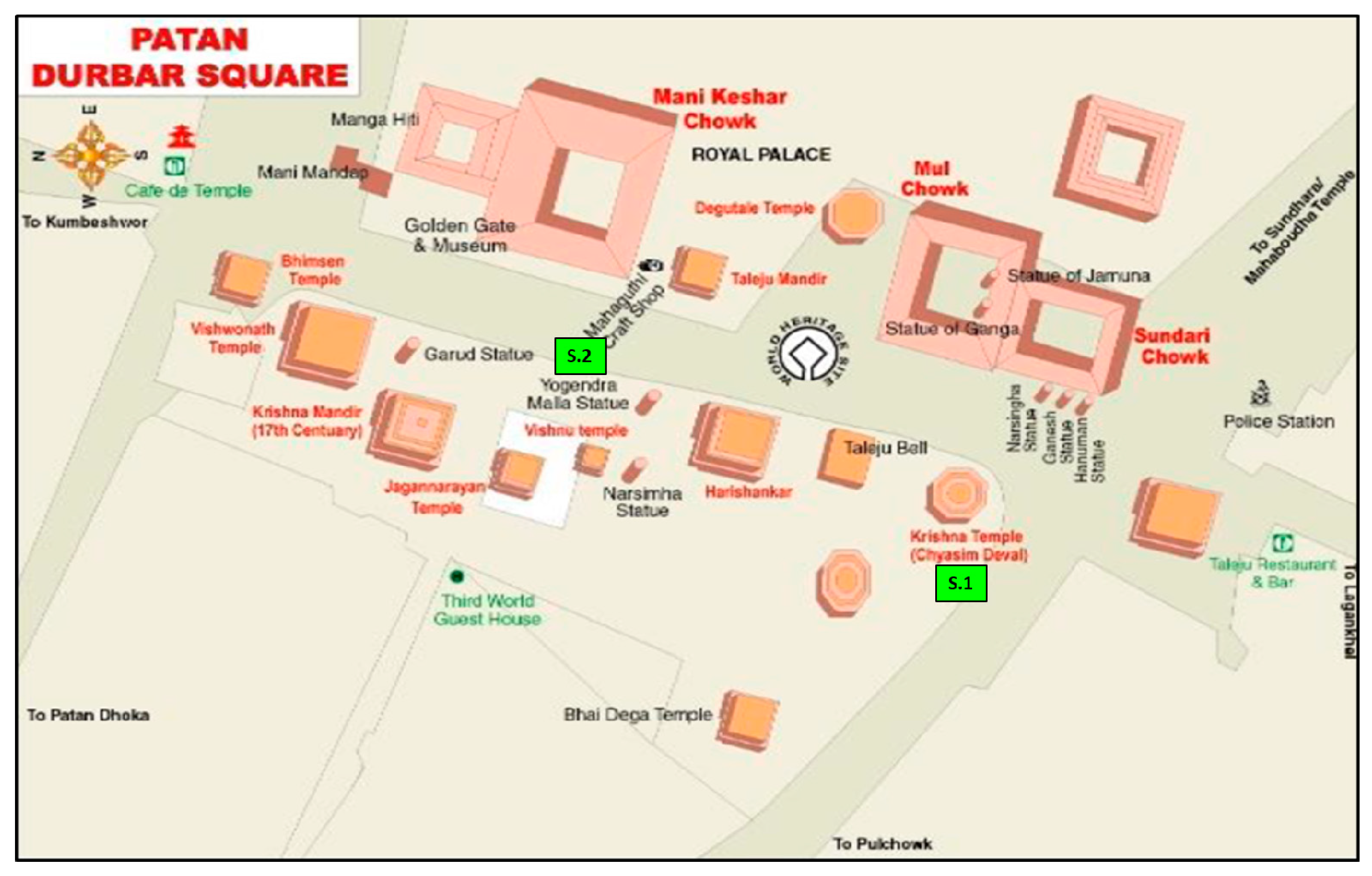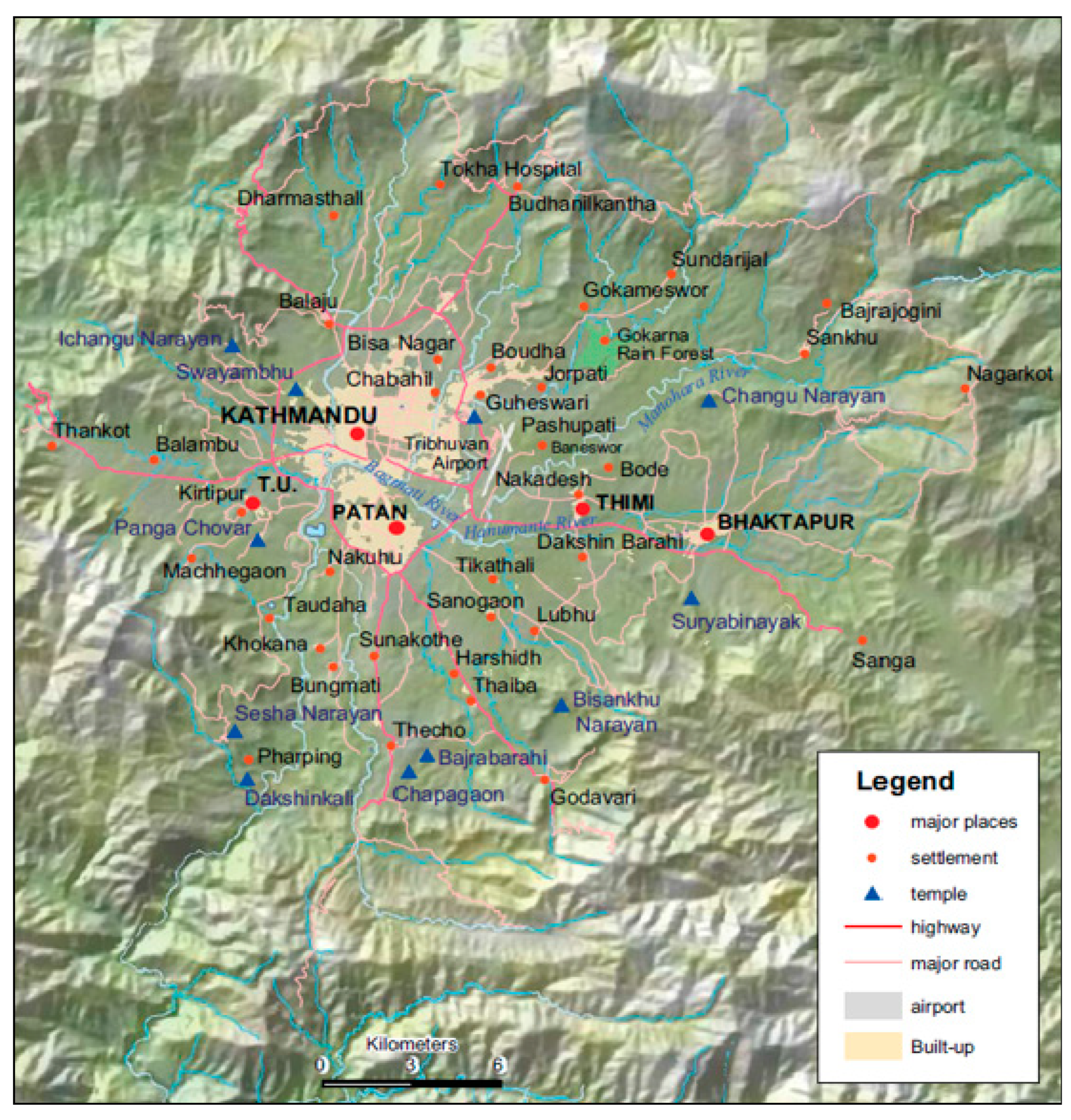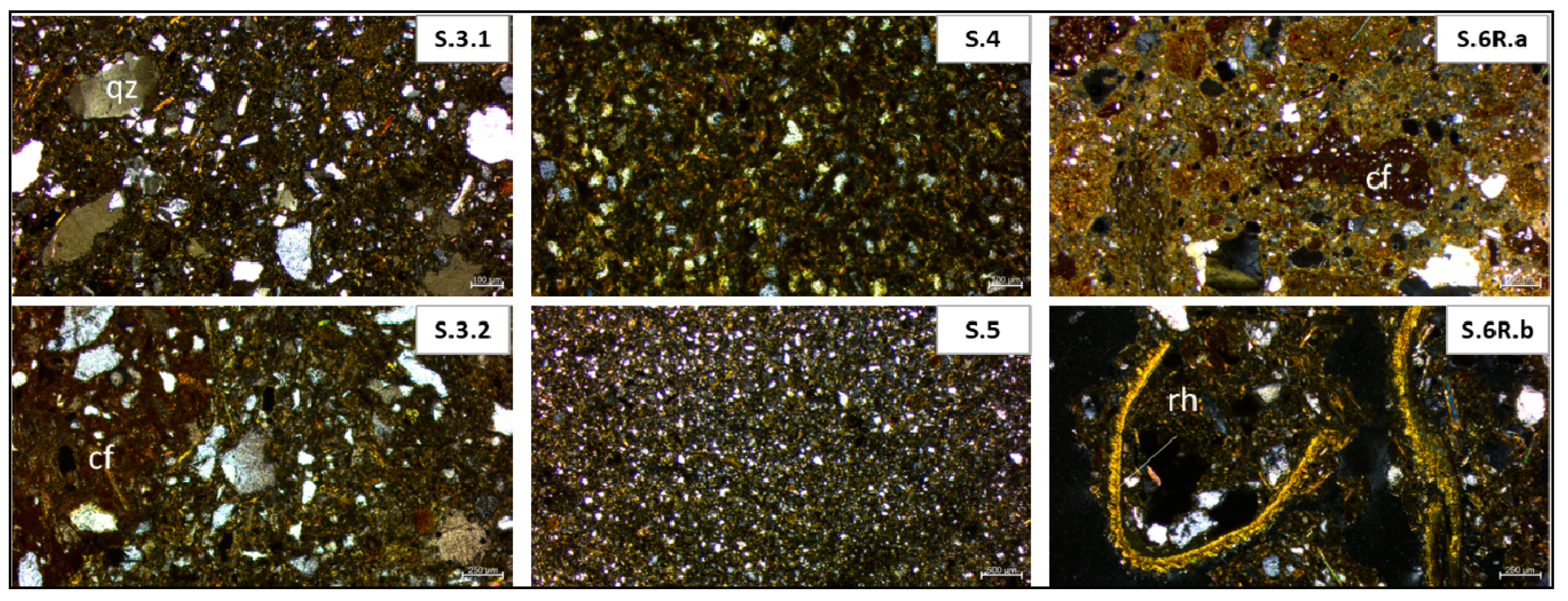A Multi-Analytical Characterization of Mortars from Kathmandu (Nepal) Historical Monuments
Abstract
:1. Introduction
2. Materials and Methods
2.1. Samples
2.2. Methodology
3. Results
3.1. Optical Microscopy (OM)
3.2. X-ray Diffraction (XRD)
3.3. Attenuated Τotal Reflectance–Fourier Transform-Infrared Spectroscopy (ATR-FTIR)
3.4. Thermogravimetric Analysis (TGA)
3.5. Petrographic Analysis
3.6. X-ray Fluorescence Spectroscopy (XRF)
3.7. Pyrolysis–Gas Chromatography–Mass Spectrometry (Py-GC-MS)
4. Discussion
5. Conclusions
Author Contributions
Funding
Institutional Review Board Statement
Informed Consent Statement
Data Availability Statement
Acknowledgments
Conflicts of Interest
Appendix A. Sample Preparation


References
- Ojha, T.P. Magnetostratigraphy, Topography and Geology of the Nepal Himalaya: A GIS and Paleomagnetic Approach. Ph.D. Thesis, The University of Arizona, Tucson, AZ, USA, 2009. [Google Scholar]
- Devkota, B.P. Revival from Rubble: Community Resilience at UNESCO World Heritage Sites in Kathmandu after 2015 Earthquake; Repository; University of Waterloo’s Institutional Repository: Waterloo, ON, Canada, 2016. [Google Scholar]
- Hutt, M. Nepal: A Guide to the Art and Architecture of the Kathmandu Valley; Adroit Publishers: Delhi, India, 2010. [Google Scholar]
- Kaphle, K.P. Mineral Resources of Nepal and Their Present Status. 2020. Available online: https://ngs.org.np/mineral-resources-of-nepal-and-their-present-status/ (accessed on 28 January 2022).
- mindat.org. Nepal. 2022. Available online: https://www.mindat.org/loc-20766.html (accessed on 28 January 2022).
- Hutt, M. The History of Kathmandu Valley, as Told by Its Architecture. 2015. Available online: https://theconversation.com/the-history-of-kathmandu-valley-as-told-by-its-architecture-41103 (accessed on 22 January 2022).
- Gellner, D.N.; Letizia, C. Hinduism in the Secular Republic of Nepal. In The Oxford History of Hinduism: Modern Hinduism; Brekke, T., Ed.; University Press: Oxford, UK, 2019; pp. 275–304. [Google Scholar]
- Sapkota, A. Hydrogeological Study of Nagdhunga Tunnel Site, Thankot, Kathmandu, Nepal. Master’s Thesis, Tribhuvan University, Kirtipur, Nepal, 2016. [Google Scholar] [CrossRef]
- Digital Himalaya. Himalayan Maps Collection. 2021. Available online: https://www.digitalhimalaya.com/collections/maps/ (accessed on 23 January 2022).
- Gellner, D.N. The Idea of Nepal; Social Science Baha: Kathmandu, Nepal, 2016. [Google Scholar]
- Corvinus, G. The prehistory of Nepal after 10 years of research. Bull. Indo-Pac. Prehistory Assoc. 1996, 14, 43–55. [Google Scholar] [CrossRef]
- Rose, L.E.; History of Nepal. Encyclopedia Britannica. (Updated). 2015. Available online: https://www.britannica.com/place/Nepal/History (accessed on 24 January 2022).
- Bonapace, C.; Sestini, V. Traditional Materials and Construction Technologies Used in the Kathmandu Valley; UNESCO: Paris, France, 2003. [Google Scholar]
- UNESCO. Kathmandu Valley. 2022. Available online: https://whc.unesco.org/en/list/121/ (accessed on 22 January 2022).
- Slusser, M.S. Nepal Mandala: A Cultural Study of the Kathmandu Valley; Mandala Book Point: Kathmandu, Nepal, 1998. [Google Scholar]
- World Monuments Fund. Cultural Heritage Sites of Nepal. 2019. Available online: https://www.wmf.org/project/cultural-heritage-sites-nepal (accessed on 18 January 2022).
- Nepal Government. Kathmandu Valley World Heritage Site: Integrated Management Framework; KAT/2007/PI/H/3; Department of Archaeology, Ministry of Culture, Tourism and Civil Aviation: Kathmandu, Nepal, 2007.
- World Monuments Fund. Durbar Square. 2015. Available online: https://www.wmf.org/project/durbar-square (accessed on 18 January 2022).
- Bothara, J.K.; Guragain, R. Facing the earthquake. Spaces 2005, 3, 82–85. [Google Scholar]
- Apil, K.C.; Sharma, K.; Pokharel, B. Performance of Heritage Structures during the Nepal Earthquake of 25 April 2015. J. Earthq. Eng. 2019, 23, 1346–1384. [Google Scholar] [CrossRef]
- UNESCO. Culture. 2021. Available online: https://en.unesco.org/node/317579 (accessed on 17 January 2022).
- Joshi, A. Gaddi Baithak: Continued glory of the legacy built by Chandra Shamsher. Spaces 2018, 3, 26–36. Available online: https://issuu.com/spacesnepal5/docs/spaces_august_2018 (accessed on 31 January 2022).
- Durham University. Post-Earthquake Rescue Archaeology in Kathmandu. 2021. Available online: https://www.durham.ac.uk/departments/academic/archaeology/research/archaeology-research-projects/post-earthquake-kathmandu/ (accessed on 30 January 2022).
- Pradhan, A.R. Hanuman Dhoka Palace: 7 Years Later. Nepal News. 2022. Available online: https://nepalnews.com/s/nation/hanuman-dhoka-palace-7-years-later (accessed on 25 February 2022).
- ICOMOS. Principles for the Preservation of Historic Timber Structures; ICOMOS: Paris, France, 1999. [Google Scholar]
- Middendorf, B.; Hughes, J.J.; Callebaut, K.; Baronio, G.; Papayianni, I. Investigative methods for the characterisation of historic mortars—Part 1: Mineralogical characterisation. Mater. Struct. 2005, 38, 761–769. [Google Scholar] [CrossRef]
- ICOMOS. ICOMOS CHARTER—Principles for the Analysis, Conservation and Structural Restoration of Architectural Heritage; ICOMOS: Paris, France, 2003. [Google Scholar]
- ICOMOS. International Charter for the Conservation and Restoration of Monuments and Sites (THE VENICE CHARTER 1964); ICOMOS: Paris, France, 1965. [Google Scholar]
- Gutshow, N. Architecture of the Newars: A History of Building Typologies and Details in Nepal; 1; Serindia Publications: Chicago, IL, USA, 2011. [Google Scholar]
- Coningham, R.; Acharya, K.P.; Davis, C.; Kunwar, R.B.; Simpson, I.; Joshi, A.; Weise, K. Resilience within the Rubble: Reconstructing the Kasthamandap and Its Past after the 2015 Gorkha Earthquake. Spaces 2018, 10, 40–49. Available online: https://issuu.com/spacesnepal5/docs/spaces_march_2018-ilovepdf-compress (accessed on 30 January 2022).
- Kinnaird, T.C.; Simpson, I.A. Geochronologies from the Kathmandu Valley UNESCO World Heritage Site: Optically Stimulated Luminescence measurement of monument foundation sediments and radiocarbon measurement of timbers. In Geoarchaeological Assessment of Post-Earthquake Kasthamandap Working Papers; 3; Biological and Environmental Sciences; University of St Andrews: St Andrews, UK, 2019; Available online: https://dspace.stir.ac.uk/bitstream/1893/29859/1/ChronologyReport_KinnairdSimpson18.pdf (accessed on 29 January 2022).
- Prajapati, R. Hanuman Dhoka Durbar Square Conservation Program. Available online: https://backtokathmandu.tripod.com/hdrp.html (accessed on 25 February 2022).
- Sanday, J. The Hanuman Dhoka Royal Palace Kathmandu Building Conservation and Local Traditional Crafts; AARP: London, UK, 1974. [Google Scholar]
- Nepal Government. Hanumandhoka Durbar and Durbar Square: A UNESCO World Heritage Monument Zone. 2021. Available online: https://hanumandhoka.gov.np/index.html (accessed on 25 February 2022).
- Manhita, A.; Martins, S.; Dias, C.B.; Cardoso, A.; Candeias, A.; Gil, M. An unusual mural paintings at the charola of the convent of Tomar: Red lakes and organic binders. Color Res. Appl. 2016, 41, 258–262. [Google Scholar] [CrossRef]
- Schilling, M.R.; Heginbotham, A.; van Keulen, H.; Szelewski, M. Beyond the basics: A systematic approach for comprehensive analysis of organic materials in Asian lacquers. Stud. Conserv. 2016, 61 (Suppl. S3), 3–27. [Google Scholar] [CrossRef] [Green Version]
- Asensio, R.C.; San Andres Moya, M.; de la Roja, J.M.; Gomez, M. Analytical characterization of polymers used in conservation and restoration by ATR-FTIR spectroscopy. Anal. Bioanal. Chem. 2009, 395, 2081–2096. [Google Scholar] [CrossRef]
- Chukanov, N.V. Infrared Spectra of Mineral Species; Springer: New York, NY, USA, 2014; Volume 1. [Google Scholar]
- Chukanov, N.V.; Chervonnyi, A.D. Infrared Spectra of Minerals and Related Compounds; Springer: New York, NY, USA, 2016. [Google Scholar]
- Bruckman, V.J.; Wriessnig, K. Improved soil carbonate determination by FT-IR and X-ray analysis. Environ. Chem. Lett. 2013, 11, 65–70. [Google Scholar] [CrossRef] [Green Version]
- Derrick, M.R.; Stulik, D.; Landry, J.M. Infrared Spectroscopy in Conservation Science; Getty Publications: Los Angeles, CA, USA, 2000; p. 235. [Google Scholar]
- Barth, A. Infrared spectroscopy of proteins. Biochim. Biophys. Acta 2007, 1767, 1073–1101. [Google Scholar] [CrossRef] [PubMed] [Green Version]
- Yang, F.; Zhang, B.; Ma, Q. Study of Sticky Rice-Lime Mortar Technology for the Restoration of Historical Masonry Construction. Acc. Chem. Res. 2010, 43, 936–944. [Google Scholar] [CrossRef] [PubMed]
- Borsoi, G.; Santos Silva, A.; Candeias, A.; Mirão, J. Analytical characterization of ancient mortars from the archaeological roman site of Pisões (Beja, Portugal). Constr. Build. Mater. 2019, 204, 597–608. [Google Scholar] [CrossRef] [Green Version]
- Cardoso, I.; Macedo, M.F.; Vermeulen, F.; Corsi, C.; Santos Silva, A.; Rosado, L.; Candeias, A.; Mirão, J. A Multidisciplinary Approach to the Study of Archaeological Mortars from the Town of Ammaia in the Roman Province of Lusitania (Portugal). Archaeometry 2014, 56, 1–24. [Google Scholar] [CrossRef] [Green Version]
- Poletto, M.; Pistor, V.; Sanatana, R.M.C.; Zattera, A.J. Materials Produced from Plant Biomass. Part II: Evaluation of Crystallinity. Mater. Res. 2012, 15, 421–427. [Google Scholar] [CrossRef] [Green Version]
- Földvári, M. Handbook of the Thermogravimetric System of Minerals and Its Use in Geological Practice; Central European Geology; Geological Institute of Hungary: Budapest, Hungary, 2011; Volume 213. [Google Scholar]
- van der Werf, I.D.; Gnisci, R.; Marano, D.; de Benedetto, G.E.; Laviano, R.; Pellerano, D.; Vona, F.; Pellegrino, F.; Andriani, E.; Catalano, I.M.; et al. San Francesco d’Assisi (Apulia, South Italy): Study of a manipulated 13th century panel painting by complementary diagnostic techniques. J. Cult. Herit. 2008, 9, 162–172. [Google Scholar] [CrossRef]
- Bonaduce, I.; Andreotti, A. Py-GC/MS of Organic Paint Binders. In Organic Mass Spectrometry in Art and Archaeology; Colombini, M.P., Modugno, F., Eds.; Wiley: Chichester, UK, 2009; pp. 303–326. [Google Scholar]
- Chiavari, G.; Galletti, G.C.; Lanterna, G.; Mazzeo, R. The potential of pyrolysis gas chromatography mass spectrometry in the recognition of ancient painting media. J. Anal. Appl. Pyrol. 1993, 24, 227–242. [Google Scholar] [CrossRef]
- Carbini, M.; Stevanato, R.; Rovea, M.; Traldi, P.; Favretto, D. Curie-point pyrolysis-gas chromatography/mass spectrometry in the art field. 2. The characterization of proteinaceous binders. Rapid Commun. Mass Spectrom. 1996, 10, 1240–1242. [Google Scholar] [CrossRef]
- Modugno, F.; Ribechini, E. GC/MS in the Characterization of Resinous Materials. In Organic Mass Spectrometry in Art and Archaeology; Colombini, M.P., Modugno, F., Eds.; Wiley: Chichester, UK, 2009; pp. 215–235. [Google Scholar]
- Sanday, J. Traditional crafts and modern conservation methods in Nepal. In Appropriate Technologies’ in the Conservation of the Cultural Property. Protection of the Cultural Heritage, Technical Handbooks for Museums and Monuments, 7th ed.; The UNESCO Press: Paris, France, 1981; pp. 9–49. [Google Scholar]
- Shrestha, R.; Koju, S.; Shrestha, R. Performance of Lime Mortar in Reconstruction of Monuments of Bhaktapur. In Proceedings of the 2nd International Conference on Earthquake Engineering and Post Disaster Reconstruction Planning, Bhaktapur, Nepal, 25–27 April 2019; pp. 185–188. [Google Scholar]
- Yang, F.; Zhang, B.; Pan, C.; Zeng, Y. Traditional mortar represented by sticky rice lime mortar—One of the great inventions in ancient China. Sci. China Ser. E Technol. Sci. 2009, 52, 1641–1647. [Google Scholar] [CrossRef]
- Fang, S.Q.; Zhang, H.; Zhang, B.J.; Zheng, Y. The identification of organic additives in traditional lime mortar. J. Cult. Herit. 2014, 15, 144–150. [Google Scholar] [CrossRef]
- Snow, J.; Torney, C. Short Guide: Lime Mortars in Traditional Buildings; Historic Scotland: Edinburgh, UK, 2014. [Google Scholar]
- Moropoulou, A.; Bakolas, A.; Bisbikou, K. Investigation of the technology of historic mortars. J. Cult. Herit. 2000, 1, 45–58. [Google Scholar] [CrossRef]










| Sample ID | Monument | Construction Date | Main Construction Material |
|---|---|---|---|
| S.1 | Krishna Mandir Temple | 17th century AD | Stone |
| S.2 | Yogendra Malla Pillar | 17th century AD | Stone |
| S.3 | Kasthamandap Temple | 11–13th century AD | Bricks |
| S.4 | Agamchhen/Hanuman-Dhoka Pallace | 15–18th century AD | Bricks |
| S.5 | Shah Kalin-Dhukuti/Hanuman-Dhoka Pallace | 19th century AD | Bricks |
| S.6 | Gaddi Baithak/Hanuman-Dhoka Pallace | 20th century AD | Bricks |
| Sample | Monument | Q | Pl | Or | Mca | Clc | G | CM |
|---|---|---|---|---|---|---|---|---|
| S.1 | Krishna Mandir Temple | ++++ | ++ | ++ | +++ | + | - | + |
| S.2 | Yogendra Malla Pillar | ++++ | ++ | ++ | +++ | + | - | + |
| S.3.1 | Kasthamandap Temple | +++ | ++ | ++ | ++++ | - | + | + |
| S.3.2 | Kasthamandap Temple | +++ | ++ | ++ | ++++ | - | - | + |
| S.4 | Agamchhen/Hanuman-Dhoka Pallace | ++++ | ++ | ++ | +++ | - | - | + |
| S.5 | Shah Kalin-Dhukuti/Hanuman-Dhoka Pallace | +++ | +++ | ++ | +++ | - | - | + |
| S.6G | Gaddi Baithak/Hanuman-Dhoka Pallace | +++ | ++ | ++ | +++ | - | - | + |
| S.6R | Gaddi Baithak/Hanuman-Dhoka Pallace | +++ | ++ | ++ | +++ | ++ | - | - |
Publisher’s Note: MDPI stays neutral with regard to jurisdictional claims in published maps and institutional affiliations. |
© 2022 by the authors. Licensee MDPI, Basel, Switzerland. This article is an open access article distributed under the terms and conditions of the Creative Commons Attribution (CC BY) license (https://creativecommons.org/licenses/by/4.0/).
Share and Cite
Tsoupra, A.; Maharjan, M.; Teixeira, D.; Candeias, A.; Galacho, C.; Moita, P. A Multi-Analytical Characterization of Mortars from Kathmandu (Nepal) Historical Monuments. Separations 2022, 9, 205. https://doi.org/10.3390/separations9080205
Tsoupra A, Maharjan M, Teixeira D, Candeias A, Galacho C, Moita P. A Multi-Analytical Characterization of Mortars from Kathmandu (Nepal) Historical Monuments. Separations. 2022; 9(8):205. https://doi.org/10.3390/separations9080205
Chicago/Turabian StyleTsoupra, Anna, Monalisa Maharjan, Dora Teixeira, Antonio Candeias, Cristina Galacho, and Patrícia Moita. 2022. "A Multi-Analytical Characterization of Mortars from Kathmandu (Nepal) Historical Monuments" Separations 9, no. 8: 205. https://doi.org/10.3390/separations9080205
APA StyleTsoupra, A., Maharjan, M., Teixeira, D., Candeias, A., Galacho, C., & Moita, P. (2022). A Multi-Analytical Characterization of Mortars from Kathmandu (Nepal) Historical Monuments. Separations, 9(8), 205. https://doi.org/10.3390/separations9080205








